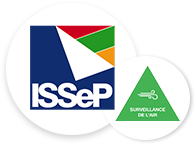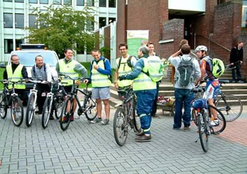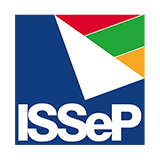Since 2014, the ISSeP Air Quality unit has been equipped with portable measuring instruments that it uses or lends to citizens to assess the concentrations of black carbon (black carbon, BC in English) and fine particles in the hearts of our towns and villages.
These high-frequency measurements make it possible to precisely locate, in time and space, the black spots in terms of atmospheric pollution. However, a large number of repetitions are necessary to draw conclusions representative of a general situation and not of particular weather or traffic conditions.
A concrete project: ExTraCar
ExTraCar (Exhibition, Traffic and Black Carbon) focuses on black carbon, the carbon and black coloured parts of fine particles resulting from incomplete combustion. In itself, this pollutant of essentially anthropogenic origin does not exhibit a toxicity greater than that of PM2.5 as a whole, but it is usually the vector of other particularly toxic components such as heavy metals or polycyclic aromatic hydrocarbons recognised as carcinogenic by the World Health Organization (WHO).
Since it is not yet regulated by a European directive, the air quality monitoring network currently only has three BC measurement sites in Wallonia, which does not provide a precise picture of concentrations throughout the region, nor does it determine the most problematic areas within a municipality. As part of this study, we worked on this second point by focusing on its measurement using portable devices, its large-scale cartographic representation, its spatiotemporal representativeness and its modelling, with an exposure approach during transport activity, too.
Through measurement campaigns at a very high spatial resolution, along targeted routes in the heart of the city of Liège and from its periphery to its centre, we have drawn up an initial image of the typical concentrations in various areas of the agglomeration and localised black points. Then, through modelling, we estimated, on the basis of emissions, meteorological conditions, the configuration of the building and measurements at fixed stations, concentrations within several areas of the city.
Repeated measurements in experiments lasting a few hours, where up to six sets of instruments were used simultaneously, were used to calibrate the model. Then, a generalisation of the modeling system made it possible to propose, at the scale of the Liège agglomeration, a more complete picture of the additional concentrations of black carbon due to traffic.
The ExTraCar project offers an IT solution to assess the impact of traffic on levels of particulate air pollution, adaptable to each Walloon municipality, through the provision of ad hoc input data, in particular on traffic.
This opens the way to even better collaboration between municipal and regional authorities in managing the problem of ambient air quality.
All the data previously collected are currently being reformatted for future use on this website via the "Itinerant measurements" map menu icon.








